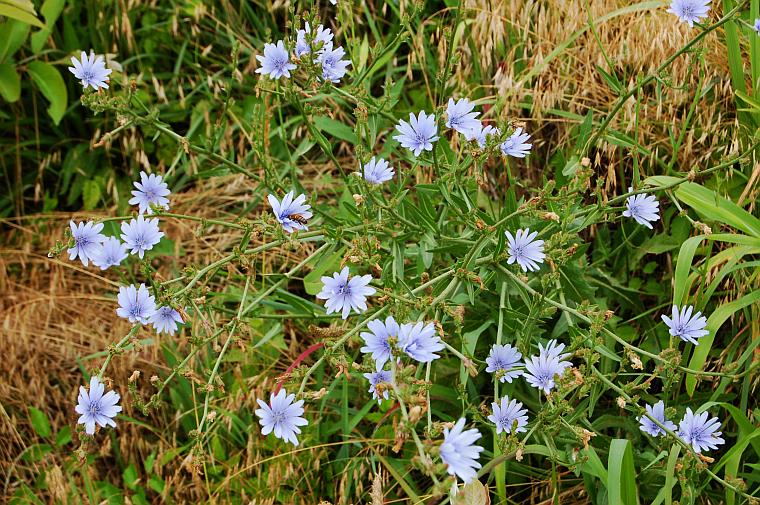Cichorium intybus L.
Common Chicory

Introduced
CC = *
CW = 3
MOC = 66
© SRTurner
Cichorium intybus L.Common Chicory | |
 |
Introduced CC = * CW = 3 MOC = 66 |
© SRTurner |
|
Family - Asteraceae/Cichorieae Habit - Perennial forb with an often large and branched taproot. Stems - Ascending to erect, to 1.5 m, often multiple from base, usually branched, glabrous to sparsely pubescent with curly, white, multicellular hairs, with milky sap.
Leaves - Alternate. Basal leaves lyrate, irregularly pinnatifid and toothed, to 35 cm long, with a winged petiole, usually pubescent. Stem leaves reduced, lanceolate, clasping, often auriculate.
Inflorescence - Panicles with ascending, spikelike branches, sometimes reduced to a single spike or spikelike raceme or appearing as small, axillary, sessile clusters of heads. Lower flowers with reduced leaf subtending. Upper flowers with no bract or bract reduced and scalelike. Heads - Sessile or short-stalked. Involucre 10-15 mm long, cup-shaped to broadly cylindrical, the bracts in 2 series, glabrous or sometimes with gland-tipped hairs, those of the outer series 4-6, 5-6 mm long, about 1/2 as long as the inner series, ovate to narrowly ovate, acute, somewhat thickened, hardened, and pale toward the base, spreading at the tip; those of the inner series 8-12, to 1.1 cm long, narrowly lanceolate to linear, acute. Receptacle flat, naked.
Ray florets - Ligulate florets 12-30. Corollas 14-25 mm long, various shades of blue, rarely pink or white, 5-toothed at apex, to 2 cm long, pubescent. Pappus a minute, low crown of numerous scales, these 0.1-0.2 mm long, irregularly truncate at the tip, white, persistent at fruiting. Anthers blue, 4 mm long, fused around style. Style blue above, white below, bifurcate. Stigma blue.
Disc florets - Absent. Fruits - Achenes 2-3 mm long, oblong-ovoid in outline, not flattened, bluntly 5-angled, truncate at the tip, the surface sometimes with 8-10 shallow, longitudinal lines, minutely pebbled to finely cross-wrinkled, glabrous, brown to nearly black, sometimes finely mottled.
Flowering - May - October. Habitat - Roadsides, fields, pastures, railroads, disturbed areas. Also cultivated. Origin - Native to Eurasia. Lookalikes - None close. The image below appeared on a coffee website discussing chicory as a coffee additive. But the plant in this image is NOT chicory - note the disk florets at the center of the head. These are absent in Cichorium intybus! This image instead appears to show a species of Symphyotrichum.
Other info. - Chicory is a common roadside weed throughout Missouri. It occurs in every state within the continental U.S., though it is uncommon in some areas. It is one of the most easily recognized plants in the state due to its big blue flowering heads and roadside habitat. During the hot summer months the flowering heads often stay open for only a short time in the morning. The plant is probably underrepresented in herbaria due to its extreme commonness and introduced status. Photographs taken in Eminence, MO., 6-27-03 (DETenaglia); also at Busch Wildlife Area, St. Charles County, MO, 8-30-2008, at Johnson's Shut-Ins State Park, Reynolds County, MO, 7-29-2013, near Labadie, Franklin County, MO, 6-16-2016, near Goodrich, Genesee County, MI, 7-3-2016, along the Katy Trail near Treloar, Warren County, MO, 7-25-2019, and at Riverfront Park, Washington, Franklin County, MO, 7-9-2025, (SRTurner). |